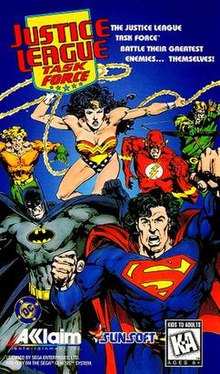
Earthworm Jim is a 1994 run and gun platform game developed by Shiny Entertainment, featuring an earthworm named Jim, who wears a robotic suit and battles the forces of evil. The game was released for the Sega Genesis and Super Nintendo Entertainment System, before being subsequently ported to a number of other video game consoles.
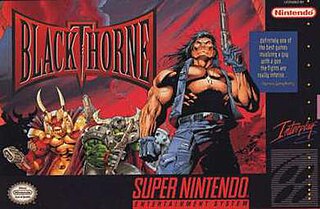
Blackthorne is a cinematic platform game developed by Blizzard Entertainment. It was released for the Super NES and MS-DOS in 1994. The cover art for the SNES version was drawn by Jim Lee. The following year, Blackthorne was released for the Sega 32X with additional content. In 2013, Blizzard released the game for free on their Battle.net PC client. In celebration of the company's 30th anniversary, Blackthorne was re-released for Nintendo Switch, PlayStation 4, Windows, and Xbox One as part of the Blizzard Arcade Collection in February 2021.
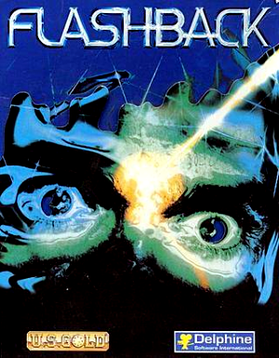
Flashback, released as Flashback: The Quest for Identity in the United States, is a 1992 science fiction cinematic platform game developed by Delphine Software of France and published by U.S. Gold in the United States and Europe, and Sunsoft in Japan.

Venom/Spider-Man: Separation Anxiety is a side-scrolling beat 'em up video game and a sequel to Spider-Man and Venom: Maximum Carnage, released for Mega Drive/Genesis and Super NES and then ported to PC. One or two players team up as Spider-Man and Venom to defeat the evil symbiote Carnage. The game boasts many thugs that the player has to defeat: heavily armed Jury and Venom's symbiote children. There is also cameo assistance from Captain America, Ghost Rider, Hawkeye, and Daredevil.

Shaq Fu is a 2D fighting game published by Electronic Arts for the Sega Genesis and Super NES on October 28, 1994. It was developed by the now-defunct Delphine Software International. Versions for the Game Gear, Game Boy, and Amiga followed in 1995. Former professional basketball player Shaquille O'Neal stars as the player character.
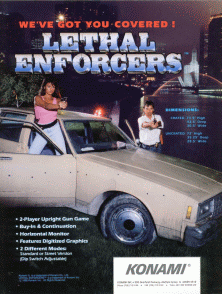
Lethal Enforcers is a 1992 light gun shooter released as an arcade video game by Konami. The graphics consist entirely of digitized photographs and digitized sprites. Home versions were released for the Super NES, Genesis and Sega CD during the following year and include a revolver-shaped light gun known as The Justifier.
XBAND was one of the first competitive online console gaming networks and was available for the Genesis and Super NES. It was produced by Catapult Entertainment in Cupertino, California. It is the only modem released in America to have been officially licensed by Nintendo. It debuted in various areas of the United States in late 1994 and 1995.

Pitfall: The Mayan Adventure is a side-scrolling action-platform video game developed by Activision in conjunction with Kroyer Films and originally published in North America and Europe in 1994. The fourth installment in the Pitfall! franchise, players assume the role of Pitfall Harry Junior as he embarks on a journey through the Mayan jungles of Central America in an attempt to rescue Pitfall Harry, his father and the protagonist of previous entries in the series, from the evil Mayan warrior spirit named Zakelua. Its gameplay mainly consists of action and platforming mixed with stage-based exploration using a main six-button configuration.

The Lion King is a platform game based on Disney's 1994 animated film The Lion King. The game was developed by Westwood Studios and published by Virgin Interactive Entertainment for the Super NES and Genesis in 1994, and was ported to MS-DOS, Amiga, Game Gear, Master System, and Nintendo Entertainment System. The Amiga, Master System, and NES versions were only released in the PAL region. It is the final licensed NES game worldwide. The game follows Simba's journey from a young cub to the battle with his uncle Scar as an adult.

The Adventures of Batman & Robin is a series of video game adaptations released between 1994 and 1995 featuring the DC Comics characters Batman and Robin based on Batman: The Animated Series. The games were released for numerous platforms, with the Genesis, Game Gear, and Sega CD versions published by Sega while the Super NES version was published by Konami.

Batman Forever is a beat 'em up video game based on the movie of the same name. Though released by the same publisher at roughly the same time, it is an entirely different game from Batman Forever: The Arcade Game. The game was followed by Batman & Robin in 1998, itself based on the movie of the same name.
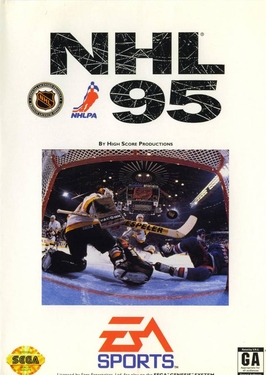
NHL 95 is an ice hockey video game developed by Electronic Arts Canada. It was released in 1994 for the Super Nintendo Entertainment System and the Sega Genesis. The team rosters and player attributes in the game reflect that of the 1994–95 season.

True Lies is a top-view run and gun video game based on the 1994 film True Lies. The game was developed by Beam Software and published by Acclaim Entertainment. Four different versions of the game were released for the Super Nintendo Entertainment System, Sega Genesis, Game Gear, and Game Boy. The home versions and portable versions are drastically different from each other, but have similar play mechanics.

Mighty Morphin Power Rangers is the title of five different video games based on the first season of the television series of the same name, one for each of the following game platforms: Sega Genesis/Mega Drive, Super Nintendo Entertainment System, Game Boy, Game Gear, and Sega CD. The Nintendo versions of the game were released by Bandai, while the Sega versions were published by Banpresto, a pseudonym of Bandai. The Green Ranger is only playable on the Genesis and Game Gear versions of the game.

Dragon: The Bruce Lee Story is a fighting video game developed and originally published by Virgin Interactive Entertainment in Europe for the Sega Genesis in June 1994. It is based on the 1993 film of the same name, which is a semi-fictionalized account of the life of Hong Kong-American actor and martial artist Bruce Lee. Following the events of the movie, players take control of Bruce Lee across several stages that takes places in different time periods of his life and fight against some of his adversaries.
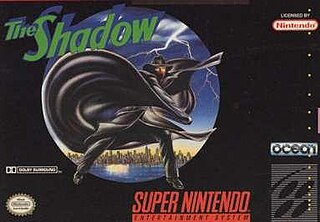
The Shadow is a video game based on the 1994 Universal film of the same name. It was planned for release in 1994 on the Super NES, alongside other systems, but was canceled.

NBA Live 96 is the second installment of the NBA Live video game series published by EA Sports and released on November 30, 1995. The PC and PlayStation covers feature Shaquille O'Neal of the Orlando Magic, while the Super Nintendo Entertainment System, Sega Genesis and European PlayStation box covers feature a photo of the tip-off to Game 1 of the 1995 NBA Finals. PlayStation and PC versions are the first games in the series to feature 3D-rendered courts, allowing for multiple camera angles using EA's "Virtual Stadium" technology, which is also used for FIFA Soccer 96. On-court player graphics remain 2D sprites. It is also the first NBA Live game released for the PlayStation. NBA Live 96 is followed by NBA Live 97.

Star Trek: Starfleet Academy – Starship Bridge Simulator is a video game for the Super Nintendo Entertainment System and Sega Genesis 32X systems that was released in 1994 by Interplay, the same group that produced many later Star Trek starship games.

Samurai Shodown, known in Japan as Samurai Spirits, is a fighting game developed and published by SNK for the Neo Geo arcade and home platform. Released in 1993, it is the first installment in the Samurai Shodown series. In contrast to other fighting games at the time, which were set in modern times and focused primarily on hand-to-hand combat, Samurai Shodown is set in feudal-era Japan and was SNK's first arcade fighting game to focus primarily on weapon-based combat.

FIFA Soccer 96 is a football simulation video game developed by Extended Play Productions and released by Electronic Arts in 1995. It was released for the Mega Drive/Genesis, Sega Saturn, Sega 32X, Game Gear, PlayStation, Super Nintendo Entertainment System, and MS-DOS compatible operating systems.
